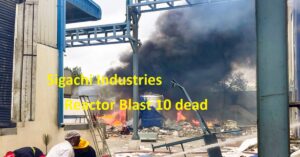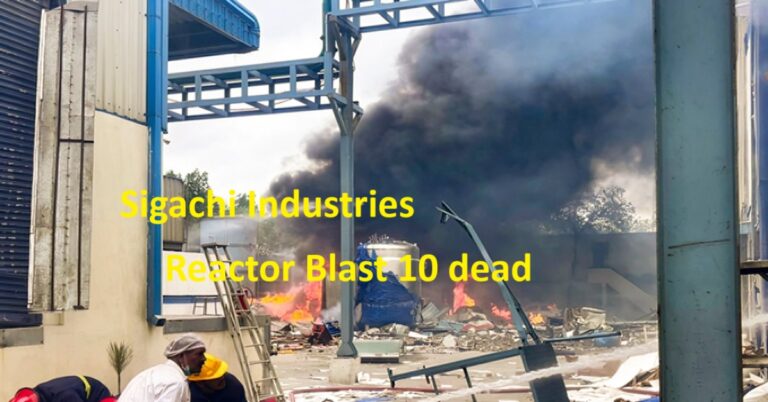Telangana Reactor blast and 10 dead as of now
Telangana Reactor blast and 10 dead as of now. On the morning of June 30, 2025, a powerful explosion rocked the Sigachi Chemical Industry located in the industrial hub of Pashamylaram, Telangana. The incident unfolded just after 9 a.m., catching workers and nearby residents off guard. The blast, which originated from a reactor within the facility, quickly escalated into a massive fire, sending thick plumes of smoke into the sky and causing chaos across the area.

Immediate Impact and Rescue Efforts
The force of the explosion was so substantial that it damaged significant portions of the factory, with debris scattered over a wide area. Many workers were caught in the blast, with some reportedly thrown several meters from their workstations. Initial reports indicate that at least 10 people lost their lives, and between 15 and 20 others sustained injuries ranging from minor to critical.
Emergency response teams acted swiftly, dispatching multiple fire engines to the site. Firefighters worked tirelessly to bring the blaze under control and prevent it from spreading to adjacent factories. Ambulances ferried the injured to local hospitals, where medical teams scrambled to treat burns, fractures, and other trauma-related injuries. District officials, including senior police and administrative officers, arrived at the scene to supervise rescue and relief operations. There are concerns that some individuals may still be trapped under the collapsed sections of the building, prompting ongoing search efforts.
Ongoing Investigation and Community Concerns
Authorities have launched a detailed investigation to determine the root cause of the reactor explosion. While the exact trigger remains unclear, initial suspicions point to a possible chemical reaction or equipment malfunction. The incident has reignited debates around industrial safety protocols, with local residents and workers’ unions demanding stricter oversight and regular safety audits.
The environmental impact of the fire is also under scrutiny. Chemical plant fires can release hazardous fumes and residues, posing health risks to both workers and nearby communities. Environmental agencies are expected to monitor air and water quality in the coming days to assess any potential contamination.
India’s Troubling History with Industrial Accidents
Unfortunately, industrial disasters are not new to India. Over the years, the country has witnessed several catastrophic events that have claimed hundreds of lives and left lasting scars on communities.
Notable Past Incidents
-
1975, Chasnala Mining Disaster (Jharkhand): An underground explosion led to flooding, resulting in the deaths of over 370 miners.
-
1984, Bhopal Gas Tragedy (Madhya Pradesh): A leak of toxic methyl isocyanate gas from a pesticide plant killed thousands and left hundreds of thousands with lingering health issues. This remains the world’s worst industrial disaster.
-
1997, Visakhapatnam Refinery Blast (Andhra Pradesh): Explosions at a refinery caused dozens of fatalities and widespread panic.
-
2009, Jaipur Oil Depot Fire (Rajasthan): A fire at an oil storage facility led to multiple deaths and forced mass evacuations.
-
2012, Sivakasi Fireworks Factory Blast (Tamil Nadu): An explosion at a fireworks manufacturing unit resulted in around 50 deaths, highlighting the dangers of lax safety in hazardous industries.
-
2017, NTPC Power Plant Explosion (Uttar Pradesh): A boiler explosion at a power plant killed over 40 workers, drawing attention to maintenance and operational lapses.
These tragedies, among others, have repeatedly underscored the need for robust safety measures, regular inspections, and strict enforcement of industrial regulations. Despite periodic improvements, gaps in compliance and oversight continue to pose significant risks.
Lessons and the Path Forward
The Telangana reactor blast is a stark reminder of the hazards inherent in industrial operations, especially in sectors dealing with chemicals and high-energy processes. Each incident brings renewed calls for reform—be it better training for workers, upgraded equipment, or more rigorous inspections. Community awareness and transparent reporting are also key to preventing future disasters.
As investigations continue and the affected families mourn their losses, there is hope that this tragedy will serve as a catalyst for meaningful change. Ensuring the safety of India’s vast industrial workforce and protecting surrounding communities must remain a top priority, so that such heartbreaking incidents become increasingly rare.

